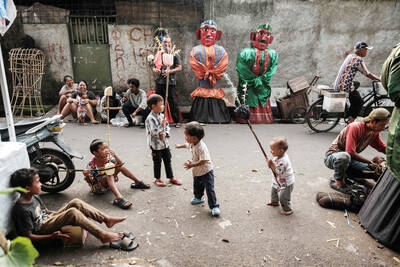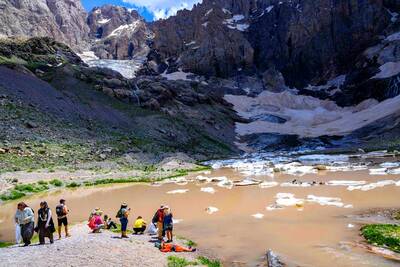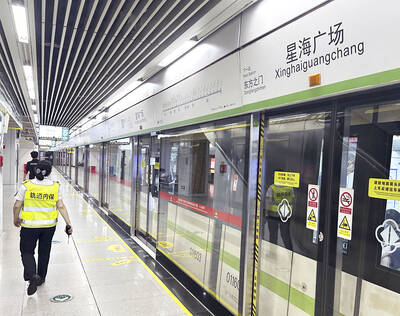Russian President Dmitry Medvedev on Friday embarked on a four-nation Latin American tour seen as sending a defiant message to the US at the close of the George W. Bush presidency.
The tour, including talks with the outgoing US leader, naval exercises off Venezuela and a visit to arch US foe Cuba, has raised fears of renewed Cold War-style rivalry in Latin America, while also attracting skepticism.
“The current level of cooperation could be broader than in the Soviet era. Latin America has already ceased to be the United States’ backyard,” a Russian diplomat told the Russian daily Kommersant ahead of Medvedev’s arrival from Portugal.
“Now the region is following its own line, which gives Russia an opportunity to strengthen our position,” the official said.
Medvedev arrived in Peru early yesterday, meeting Bush at the APEC forum, where Russia’s anti-US stance and absence from the WTO contrasts with most APEC states.
Officials said Bush and Medvedev would discuss the global financial crisis, the August war in Georgia and the touchstone issue of US missile defense plans in eastern Europe.
Today, Medvedev was also to hold talks with Chinese President Hu Jintao (胡錦濤), whose own Latin American tour this week underlined growing outside interest in the region.
Russian analysts say Moscow’s quest for influence in Latin America is intended to counter US influence in the former Soviet satellites of eastern Europe, the Caucasus and Central Asia.
Tomorrow, the Russian leader heads to Brazil, a key trading partner.
On Wednesday, he goes to Venezuela for talks with Venezuelan President Hugo Chavez, a vocal critic of Washington, as Russian warships prepare for joint exercises in the Caribbean Sea.
Russian media say officials will pursue arms and energy deals with Venezuela, whose Russian weapons purchases have prompted concern that arms stockpiles could fall into the hands of leftist rebels in neighboring Colombia.
Lima-based analyst Alejandro Deustua, of the country’s Diplomatic Academy, criticized Russia’s role in South America, saying it was time for Russia to “explain plainly to each South American country what their intentions are with these military exercises.”
Russian Foreign Minister Sergei Lavrov insisted Russian weapons sold in Latin America were defensive rather than offensive and that Russian moves were not aimed at “third countries” — a clear reference to the US, RIA Novosti reported.
Medvedev rounds off his tour in Cuba, the flagship ally of the Soviet Union in the Cold War and the US’ communist foe in the western hemisphere since the late 1950s.
Russian energy firms have been seeking projects in Latin America such as possible involvement in a planned South American gas pipeline.
A proposed Russian purchase of Spanish energy company Repsol — a major player in the region — could advance such goals.

In the sweltering streets of Jakarta, buskers carry towering, hollow puppets and pass around a bucket for donations. Now, they fear becoming outlaws. City authorities said they would crack down on use of the sacred ondel-ondel puppets, which can stand as tall as a truck, and they are drafting legislation to remove what they view as a street nuisance. Performances featuring the puppets — originally used by Jakarta’s Betawi people to ward off evil spirits — would be allowed only at set events. The ban could leave many ondel-ondel buskers in Jakarta jobless. “I am confused and anxious. I fear getting raided or even

Kemal Ozdemir looked up at the bare peaks of Mount Cilo in Turkey’s Kurdish majority southeast. “There were glaciers 10 years ago,” he recalled under a cloudless sky. A mountain guide for 15 years, Ozdemir then turned toward the torrent carrying dozens of blocks of ice below a slope covered with grass and rocks — a sign of glacier loss being exacerbated by global warming. “You can see that there are quite a few pieces of glacier in the water right now ... the reason why the waterfalls flow lushly actually shows us how fast the ice is melting,” he said.

Eleven people, including a former minister, were arrested in Serbia on Friday over a train station disaster in which 16 people died. The concrete canopy of the newly renovated station in the northern city of Novi Sad collapsed on Nov. 1, 2024 in a disaster widely blamed on corruption and poor oversight. It sparked a wave of student-led protests and led to the resignation of then-Serbian prime minister Milos Vucevic and the fall of his government. The public prosecutor’s office in Novi Sad opened an investigation into the accident and deaths. In February, the public prosecutor’s office for organized crime opened another probe into

RISING RACISM: A Japanese group called on China to assure safety in the country, while the Chinese embassy in Tokyo urged action against a ‘surge in xenophobia’ A Japanese woman living in China was attacked and injured by a man in a subway station in Suzhou, China, Japanese media said, hours after two Chinese men were seriously injured in violence in Tokyo. The attacks on Thursday raised concern about xenophobic sentiment in China and Japan that have been blamed for assaults in both countries. It was the third attack involving Japanese living in China since last year. In the two previous cases in China, Chinese authorities have insisted they were isolated incidents. Japanese broadcaster NHK did not identify the woman injured in Suzhou by name, but, citing the Japanese